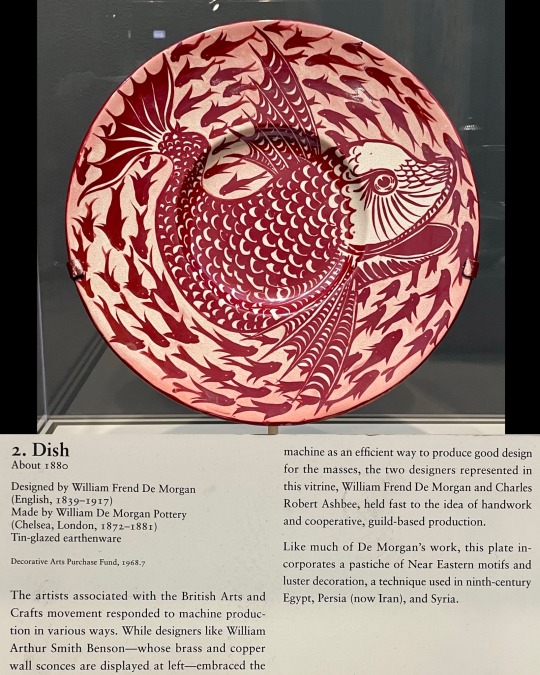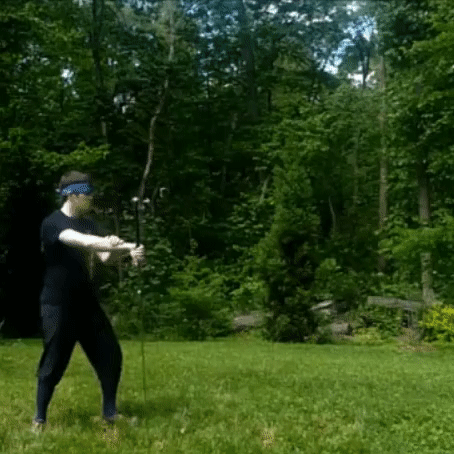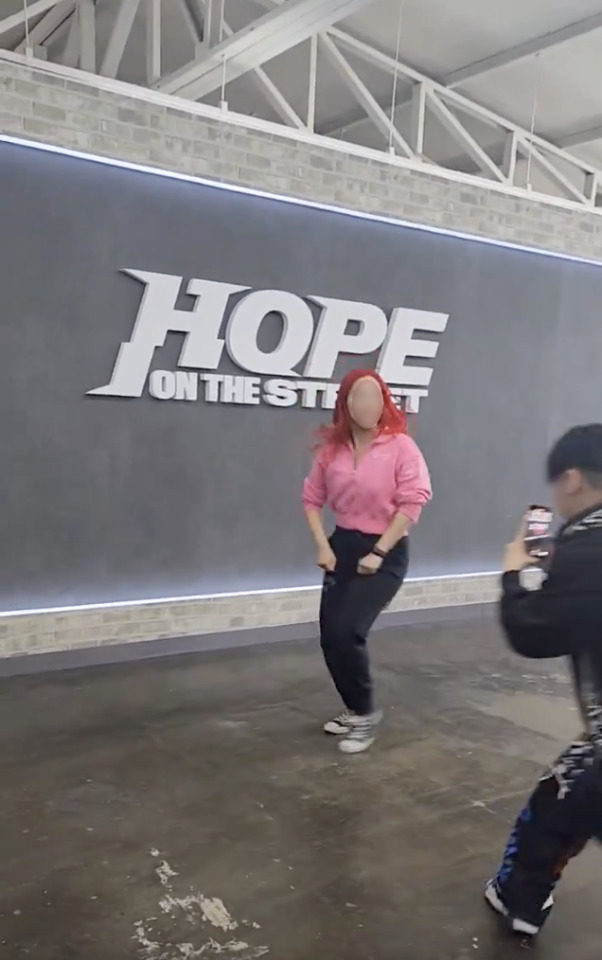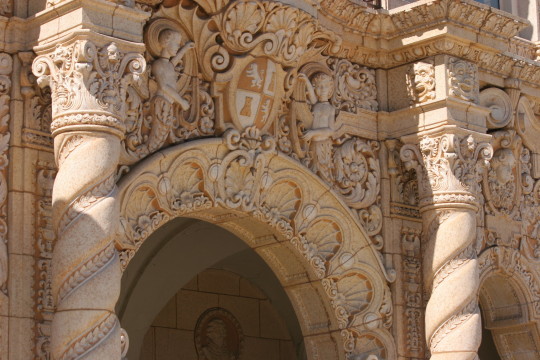#Chicago art movement
Text

Winslow Homer (1836-1910)
"After the Hurricane, Bahamas" (1899)
Watercolor and graphite on paper
Realism
Located in the Art Institute of Chicago, Chicago, Illinois, United States
#paintings#drawings#art#artwork#genre painting#genre scene#winslow homer#watercolor#watercolour#graphite#drawing#fine art#realism movement#art institute of chicago#museum#art gallery#american artist#male portrait#portrait of a man#black man#beach#bahamas#caribbean#ocean#sea#weather#disaster#1890s#late 1800s#late 19th century
99 notes
·
View notes
Text

Ballet Dancers (1886) - Henri de Toulouse-Lautrec
#art#painting#art history#artwork#art institute of chicago#art museum#oil painting#museum#work of queue#dancers#ballet dancers#henri de toulouse lautrec#toulouse lautrec#1880s#movement in paintings#french art
19 notes
·
View notes
Text
For #FishyFriday:

Dish, c.1880
Designed by William Frend De Morgan (English, 1839-1917)
Made by William De Morgan Pottery (Chelsea, London, 1872-1881)
tin-glazed earthenware
Art Institute of Chicago
“The artists associated with the British Arts and Crafts movement responded to machine production in various ways. While designers like William Arthur Smith Benson--whose brass and copper wall sconces are displayed at left--embraced the machine as an efficient way to produce good design for the masses, the two designers represented in this vitrine, William Frend De Morgan and Charles Robert Ashbee, held fast to the idea of handwork and cooperative, guild-based production.
Like much of De Morgan's work, this plate incorporates a pastiche of Near Eastern motifs and luster decoration, a technique used in ninth-century Egypt, Persia (now Iran), and Syria.”
#fish#fishes#English art#British art#European art#19th century art#Arts and Crafts Movement#cermaics#decorative arts#dish#art institute of chicago#Fishy Friday#animals in art
11 notes
·
View notes
Photo




The Chicago Arts and Crafts Society
Though it began in Britain, the Arts and Crafts Movement proved internationally popular, and its social and artistic values were quickly adopted in America. Like its British equivalent, the American Arts and Crafts Movement was as much a social movement as an artistic one. It focused on the same goals of improving the lives and working conditions of workers and reforming industrial design. Adherents sought to do this is several ways. Firstly, they thought that well made and beautifully designed objects should be available at prices that workers could afford. Secondly, they tried to introduce workshop practices that combined the artisan and the designer. A basic premise of the Arts and Crafts Movement was that happy workers made beautiful, well made goods, and beautiful, well made goods made happy workers.
As part of this goal, the Arts and Crafts Movement supported trade and design schools to teach handicrafts and design skills to workers. The Movement tended to look backward for its inspiration, towards what they saw as the ideal medieval workshop model. In this model of production, the artisan was both maker and designer, and he produced his piece from conception to completion, rather than the diversified specialization model of modern industrial production, in which which not only were the craftsman and the designer separate, but a given worker might only work on a single aspect of an object, rather than making a whole object from start to finish.
However, unlike its British counterpart, the American Arts and Crafts Movement was not opposed to the use of machines in production. In his essay “Art and Craft of the Machine” Frank Lloyd Wright, a founding member of the Chicago Arts and Crafts Society, argues that there was nothing inherently wrong with the use of the machine, so long as it is used in a way that alleviated the drudgery of the workman, rather than attempted to replace him.
The Arts and Crafts movement took the form of various Arts and Crafts societies. Chicago was an early adopter of the style. The Chicago Arts and Crafts society was started in 1897 at Hull House by a group of artistic and social reformers, including Jane Addams and Frank Lloyd Wright.
Jane Addams and Ellen Star started Hull House as a settlement house in Chicago's near west side, which at that time was largely populated by working class immigrant communities. Settlement houses were a product of 19th century social reform thinking. They sought to bring educated, middle class reformers to “settle” in poor, working class areas to assist in moral, social, and economic uplift. Some settlement houses had a religious background, while others, like Hull House, were entirely secular; they all sought to improve the lives of the urban poor by providing education, trade and artistic skills, as well as access to the arts in the forms of art galleries, music, dance, and theater.
The Arts and Crafts Movement fit with Hull House’s larger mission of social reform. Hull House worked to provide opportunities, primarily through education in useful trade and handicraft skills, to immigrants and the poor in Chicago, as well as moral and spiritual improvement through art.The Chicago Arts and Crafts Society’s goals were “ 1.To cultivate in its members, and through them in others a just sense of beauty 2.To call the attention o.f those engaged in the production of articles of every day use to the possibility of of developing in these articles the highest beauty through a vital harmony with the conditions of production. 3.To influence the present movement toward manual training and art education… 5. To recognize and encourage handicraft among its members and through them in others, in order that the stimulation derived from this means may be helpful factor in the development of those new ideals which present conditions, to-wit, industrial organization and the machine render necessary. 6. To consider the present state of the factories and the workmen therein and to revise lines of development which shall retain the machine in so far as it relives the workman form drudgery, and tends to perfect his product; but which shall insist that the machine no longer be allowed to dominate workman and reduce his production to mechanical distortion...”
Image1: Jane Addams was born in 1860. During her life time, she would become a settlement activist, social worker, reformer, sociologist, public administrator, and author. She was an important leader in the history of social work and sociology. She is best know for starting Hull House with her partner Ellen Gates Starr. She worked for women’s suffrage, and world peace. Along with Frank Lloyd Wright, and Ellen Gates Starr she was on of the founding members of the Chicago Arts and Crafts society. Image Credit: Wikipedia.
Image 2:Ellen Gates Starr was born in 1859. During her life she was a settlement activist and reformer. Along with her partner, Jane Addams, she helped to found Hull House. She was a firm believer in the Arts and Crafts Movement, and worked to promote public learning and appreciation of beauty as a sign of good citizenship. Image Credit: Wikipedia
Image 3 &4:The Chicago Arts and Crafts Society was founded at Hull House in 1897. Its founders included Jane Addams, Ellen Gates Starr, and Frank Lloyd Wright. The Society worked to promote the Arts and Crafts Movements ideals of design and social reform, and appreciation of beauty. Image Credit: The Art Institute of Chicago.
16 notes
·
View notes
Text

Ames Monument 1882 - Architect Henry Hobson Richardson
Standing in an open western grasslands stands a 60 foot Cairn memorializing the financiers of first transcontinental railroad. The Monument itself stands on the highest elevation of the original route, however, the significance of this Monument is not the achievement of the railroad but instead the contribution to a material shift which had influence on modern architecture.
Richardson was amoung the 'first proudly' American Architects who sought to create their own distinct style from European influence, later refered to as the Chicago school. The colonial nature of the American nation, as well as their art/architectural stylings, had primarily derived from the Old World. New World architects began to grow increasingly interested in exploring the material resources in the vast territory now easily accessible for settler claim.
The Cairn Monument utilizes local granite blocks which match the surrounding landscape and seeks to meld old world classical architecture with a vernacular material language. At the time there was an ongoing debate surrounding craft and industry, discovering a dynamic of merging the two became the next big movement in architecture. Following this usuage of new material language Richardson applied these theories to his Marshal Field Wholesale Store (1885-87) in Chicago: Old theories of design practice utilizing new technology and ideas. this cairn serves as such a precursor for the coming architectural stylings which inspired aspects of the Prairie School, Arts and Crafts Movement, and Internation style.
Ph: Wyoming State Historic Preservation Office
#henry Hobson Richardson#chicago school#arts and craft movement#industrial architecture#modern architecture#american architecture#monument#architecture at the end of the world
2 notes
·
View notes
Note
Thoughts on zweihanders?
Zweihänders are SUPER fucking cool! If I had a spare $900 I would totally get one.
A lot of video games and other media actually get them wrong, though. Slamming a sword that big into the ground is gonna really damage the sword, but abruptly stopping something with that much momentum can severely damage your joints and muscles if you aren't careful. You want the sword to only come to a stop when it's either hitting something you want to hit or when stopping its movement won't injure you. The trick, then, is to let the momentum of the sword carry it into this very beautiful flowing cutting pattern where the sword and its wielder are working together.
So, in practice, zweihänder/doppelhänder/montante/spadone looked less like this:

And more like this:

Some fun zweihänder facts:
"Zweihänder" is specifically a German name for this kind of sword. "Montante" was the word for more or less the same kind of sword in Spain, and in Italy they were called "Spadone."
There are some particularly massive swords of this style called "Paradeschwert" that were purely ceremonial. I saw a few at the Chicago Art Institute last time I went that were absolutely enormous.
It wasn't too uncommon for these swords to have wavy "flamberge" blades.
The prongs on the blade are called "parrying hooks."
The Landsknecht mercenaries famously used zweihänders to push past enemy pikes and break front lines.
Aside from Landsknecht, they were also used by bodyguards.
Flamberge zweihänders are still used today by the Papal Swiss Guard for ceremonial purposes.
1K notes
·
View notes
Note
Now you mentioned i, I am a bit surprised Smallville is prominently and consistently in Kansas? It's Smallville, Kansas. There might be others and certainly cities located vaguely within a real region, but it's definitely the first fictional town or city of D.C. in a real-world American state to come to mind.

So this gets to the weirdness of D.C geography. When Superman was first established, there was much less of a cohesive "universe," so if Siegel and Shuster wanted Superman to specifically be raised in Kansas, that's where he was from and the rest of the geography would have to work itself out.
IMO, this early slapdash approach to world-building has (over time) led to some things that just don't make sense to me as a student of urban history and urban studies:
Metropolis shouldn't be in Delaware. It doesn't make sense in terms of urbanization, given the context of an already-crowded Northeastern Corridor - Delaware simply does not have the capacity to sustain a city of 11 million people, and you wouldn't get a municipality of that size right next door to New York City (as well as D.C's other fictional cities in the area). The whole idea of Metropolis and Gotham being across the river/bay from each other has never really worked for me; you can still do Superman/Batman team-up stories no matter where they are, because Superman can fly and Batman has his own personal fighter jets.
More importantly, it doesn't make sense in terms of historic patterns of urban migration. Moving to the big city in search of the American Dream is a big part of the Clark Kent story, but historically people moving from rural to urban areas overwhelmingly go to the nearest large city, depending on how transportation networks are arranged, whether we're talking about train lines or direct flights or highways or bus routes. There is a reason we can track regional movements of black communities during the Great Migration, because who went where depended on which train lines ran through which states:

This is why I've always felt that, while Metropolis has aesthetically been associated with New York City, it logically should be Chicago. It is the biggest city in the Midwest, one very much associated with robber baron industrialists and corruption at the highest levels, and absolutely stuffed with art deco architecture for Superman to pose on top of. Up until the Tribune Company began to strip it for parts, it's also been a major newspaper town with a long tradition of muck-raking investigative journalism that would inspire a starry-eyed cub reporter like Clark. As one of the original transit hubs and the U.S' own "nature's metropolis," it is precisely the place that a Kansas farm boy would hop a train to, because all trains go to Chicago. Also, culturally I like it better that Clark Kent represents the City of Wide Shoulders whereas Bruce Wayne is the typical Tri-State Area Type-A personality.
Going back to D.C's bizarro Northeast geography, I likewise have an issue with Gotham being in New Jersey...if New York City is also supposed to be a major metropolitan area in the D.C universe. Just as Delaware would struggle to support a city of 11 million people, it would be very difficult to grow Gotham into a city of 10 million people so close to the gravity well of the Greater New York Metro Area. New Jersey is a pretty urbanized state, but its biggest cities tend to range in population from 300,000 to 100,000 - which works very well for a place like Blüdhaven, which is supposed to have something of an inferiority complex vis-a-vis Gotham - because a lot of the population tends to gravitate to NYC for work and eventually housing as well.
I've already said my piece about the lack of cultural specificity of D.C's Midwest.
As far as the West Coast goes, I've always found it a bit odd that Star City isn't where Seattle is supposed to be. Let's face it, the only place where Oliver Queen's facial hair would go unnoticed is Seattle. Also, Coast City is often depicted too far north on the map - if it's supposed to be a half-hour away from Edwards Air Force Base, it should be significantly more southern, down by Kern County and San Bernadino County, not practically up in San Francisco.
#dc#dc meta#the world outside your window#urbanization#urban studies#urban migration#urban demographics
106 notes
·
View notes
Text

Alexander Calder ‘Cat Mobile’ 1966
In his first published book, Animal Sketching, cats were the first about which Calder spent an entire chapter. He wrote: “If it is alertly awake, get the attitude; all the muscles tense, ears erect, eyes observant, tail poised to give the best balance for a sudden spring.”
Calder’s kinetic sculpture ‘Cat Mobile’ currently archived at the Museum of Contemporary Art (MCA) Chicago, well captures a cat’s potential energy while keeping a balance amid random movements generated by air currents.
#art#kinetic art#modern art#sculpture#moda 365#alexander calder#calder#contemporary artist#contemporary#contemporary art#art of the day#artist of the day
46 notes
·
View notes
Text
Bangtan weekly report
I hope everyone is having a great day so far. It's been a busy week/weekend for Bangtan.
Hobi's Hope On The Street album dropped on Friday and I got my ass to Target first thing to get it!

The album is amazing, as I knew it would be. Hobi continues to amaze me. I'm struggling to find the right words to express how I feel about him. As I told my bestie, Hobi is the blood and bones of BTS. Namjoon might be the big brain lyricist, the leader and Yoongi might be the constant melody maker and realist, but Hobi makes the whole thing come alive and beat with movement.
The first two episodes of the HOTS docu-series were also amazing. To hear and see him delving so deeply into the thing that makes him who he is and therefore makes BTS what it is brought tears to my eyes.
The Hope On The Street Pop Up location in Seoul is an overwhelming success as were the parties that Hobi threw for fans in LA, Chicago and NYC.
Items from his Hybe studio are on display at the Seoul pop up event and merch that is available there might be the same that will be available on April 9 on Weverse Shop.
Neuron dance lessons were being conducted today and look like they are being filmed. Maybe they will end up in a future Bangtan Episode! If you'd like to see more of what's inside the pop up, you can view this thread on X.

(image from @ddaisyy94 on X)
Yoongi has entered the Nonsan Training Center, the same one where Namjoon and Tae did their basic training. Yoongi's basic training will last 3 weeks and then he will return to his alternate service assignment. He looks so good! (sarcasm)

And it was mentioned that Jin accompanied Yoongi on this day. Jin wasn't going to let Yoongi enter military basic training without having his only hyung in the group see him off.

Speaking of Jin, his Weverse post for March was 77 DAYS LEFT!

Jimin has made a scholarship available at the Department of Physical Therapy at Dongeui Science University in Busan. According to the information, Jimin made this donation prior to enlisting. Physical therapists are important in his and the members' lives to keep them healthy while performing at such high levels.

Taehyung was spotted at a soccer match in Chuncheon. He was with a group of fellow soldiers in uniform. However, also present were Manager-nim and several recognizable Hybe security guys. Interesting.


Namjoon shared some moments from his weekend with us. I will assume he is taking his proper holiday now that he's past the 100-day mark of enlistment. He visited Sorol Art Museum in Gangneung, he hugged the sky at a beach, smelled the cherry blossoms and was lurking in and about the Hybe building because he saw a banner from Army. It's possible the banner was installed by the owner of a nearby restaurant.

Hiding his beard stubble with hotteok:

Stopping to smell the flowers during his time off:

Hugging the sky at the beach:

And I can't leave my precious Kookie off this week's report. We don't know if he and Jimin have taken the vacation that is due them now that they've also passed the 100-day milestone of their enlistment. They've completed just over 20% of their obligation as of yesterday/today and tomorrow they will be promoted to Private First Class II.

We've seen more pics of Bam than of JK this year.

(photo from @holicare.barf on Instagram)
56 notes
·
View notes
Text

MC5 - Saginaw Civic Center, Saginaw, Michigan, January 1, 1970
Since we said goodbye to John Sinclair yesterday, let's say goodbye today to Wayne Kramer, the MC5 co-founder also passed away this year. The Motor City 5 at the dawn of the damn 1970s! Things were gonna get darker during the decade ahead of them, but onstage in Saginaw on New Year's Day, they sound like true rock n roll gods.
The band's second LP, Back in the U.S.A., would be released a couple weeks later, and the band tears through a fair amount of that LP, in addition to plenty of stuff from the debut. Kramer is on fire throughout, dueling marvelously with his six-string comrade Fred "Sonic" Smith, kicking out the jams like there was no tomorrow. Maybe there wasn't any tomorrow.
Wayne Says: The MC5 took a different tact. Although we loved Miles, we plugged into the more angry and the more passionate visceral free jazz movement of the late '60's- the music of Coltrane, Ornette and Albert Ayler and Sun Ra. Joseph Jarman (Art Ensemble of Chicago) lived next door. This was the community that we had. We were all sharing this sense of what was happening in this off-shoot of jazz that seemed to parallel what we felt what was happening conscious-wise in the streets. They were way more committed and way more passionate than what Miles did. What we were really trying to do was, in my opinion, the same thing. There was no difference between what Joseph Jarman and Charles Moore and the MC5 were doing even though we came from a guitar rock perspective and they came from a traditional jazz perspective. We were all trying to get through that door that Sun Ra opened up, that Ayler opened up, that Coltrane opened up, that Pharoah Sanders and Archie Shepp opened up. That was the music that inspired (us). That's what we were striving for.
45 notes
·
View notes
Text




Loie Fuller ca. 1905
Marie Louise Fuller was born in a suburb of Chicago in 1862, and quickly began a career as a child actress. With no formal training, she developed an interest in dance and choreography. Rather than attempt classical ballet or other traditional dances, she came up with her own form of free dance. Her pieces used flowing silk costumes as canvases for dynamic multicolored lighting. Performing under the name Loie, Fuller took her performances on the road, and settled in France. There, she mesmerized audiences with her unique dances and gained the friendship of artists and intellectuals, including Auguste Rodin and Marie Curie. Her liquid movements and costumes also made her a popular subject for Art Nouveau painters and sculptors.
source
190 notes
·
View notes
Note
Hello. Sensitive question here but I wanted to ask since you stated you are from the U.S. as well. Is it now common to place an x to "neutralize" the gender of all encompassing nouns? I read a volunteer post on social media stating Hijxs and niñxs and threw me for a loop because the grammar is hijos and niños for children in general (boys and girls), right? Is this a lexicon change or just a U.S. thing?
It's just a US thing for the most part - many Latin Americans and even Spaniards see the X as an American thing
(The history is more nuanced but my sources say it came from the queer/drag community in Brazil of all places, but people would spray paint an X on gendered signs especially when "masculine plural is default inclusive" became a viewpoint)
...
The real problem with using X (aside from general perception of Latinx being a US-Hispanic thing) is that it's hard to pronounce and not great for accessibility
It makes more sense in reading it and written down, not so much speaking. People still do it in written things. When I was growing up before the Latinx movement people would use the @ (arroba) because it was part A part O... so we used to see like ¿tienes much@s amig@s? for "do you have a lot of friends?" and it was implied any gender. It's less common now because the @ often brings up social media stuff
-
The most widely accepted gender neutral is the use of -E endings; many unisex adjectives use -E [like inteligente or valiente] and it appeals more to pan-Hispanic sensibilities because E looks more Latin
And people like the E more because they see it as more organic to Spanish and less of a US-driven movement
I wrote more about the use of E in some posts related to Baldur's Gate 3:
This post here
And this larger post here
Note: Also the E can be used with Spaniards or Spanish-American people; "Latinx" specifically refers to Latin Americans, and the X is not very often used with Spaniards in my limited experience [though español/española doesn't go very well with the X in my opinion]... the E is more universally applicable
I've seen Spaniards use vosotres for "all of you [informal]" with a gender neutral twist
...
Me personally I tend to see Latinx as referring to people of Latin American descent living in the US. It's more commonly seen for talking about writers and artists of Latin American descent, and especially in the art scene to differentiate them from white artists while also not lumping them into everyone who's a person of color... since Latin Americans come in every color and shade and it's not technically a race
It's more commonly seen and used around New York, Los Angeles, Chicago, and Miami (I personally tend to associate it more with Mexican-Americans but that might be from reading about the Chicano/Chicanx art/literature movements)
54 notes
·
View notes
Text










Thomas Hart Benton (1889-1975, American)
Born in Missouri into a politically influential family in 1889, Benton found inspiration among working class communities in rural America. A prolific painter, sculptor, printmaker and gifted storyteller, Benton is credited with leading the Regionalist movement in the United States early in his career. He has long been celebrated as the most innovative practitioner of mural painting depicting American life.
Benton studied at prestigious institutions including the Art Institute of Chicago in 1907 and the Académie Julian in Paris, where he met fellow American painter, Synchromist Stanton Macdonald-Wright. Settling in New York in 1911, Benton’s work remained largely abstract until the early 1920s. On a 1924 trip home to visit his father, he was inspired to revisit his midwestern roots and began painting American rural subjects such as life in coal mines, steel mills and cotton fields. The influence of Spanish Old Master El Greco is evident in Benton’s naturalistic style, sculpted figures and fluid lines. While the rhythmic distortions of Benton’s compositions were informed by his European study, his work reflects a vibrant diversity that is distinctly American.
Benton was the first artist to be featured on the cover of Time magazine and his murals hung at an early site of the Whitney Museum of American Art. It was during this time that Benton formed a close alliance with his student - and frequent guest at his Martha’s Vineyard studio - Jackson Pollock.
https://schoelkopfgallery.com/art.../129-thomas-hart-benton/
23 notes
·
View notes
Text

SAMIA HALABY, "Fern," 1974,
Color pencils on cream wove paper,
516x710 mm / 20 1/2x27 3/4 inches.
Mrs Halaby (born 1936) is a Palestinian artist, activist and scholar known for her abstract painting. Born in Jaffa, she left in 1948 fleeing Palestine and eventually settled in the United States.
She studied at the University of Cincinnati and Indiana University, Bloomington before beginning her artistic career.
Her works are characterized by colorful geometric compositions inspired by nature and Islamic architectural forms, as well as Soviet Constructivism and other European avant-garde movements.
Her work is in included in the permanent collections of the Guggenheim Museum, New York, the Chicago Institute of Art, Institut Du Monde Arabe in Paris, and The National Gallery of Art in Washington, D.C., among others.
#art#abstract#abstraction#painting#forms#abstractart#palestine#palestinian art#pencil#fern#samia halaby#activism#jaffa#composition#geometric#colorful#constructivism#avant-garde
61 notes
·
View notes
Note
what's ur fave bldg in chicago? I went on an architecture boat tour and I'm obsessed with marina city
first of all, the architecture boat tour is great, and yes, people do look at me weird when I recommend it for residents and tourists alike---but I'm right and everyone who has taken the tour agrees with me.
anyway, I have many, many favorite buildings in Chicago (seriously, I have a list) but I'm going to talk about one of the less-discussed:
The Garfield Park Fieldhouse!
To set the scene: many Chicagoans (including architects, and social activists) had attended the World's Columbian Exposition of 1893, hosted on the south side of the city. Many had been inspired by Fredrick Law Olmsted's landscaping, and fervent belief that public green spaces were an important asset to any city. Driven by this belief, the existing park commissions (founded 1869) started getting more aggressive about translating the newfangled "city park" concept into reality. The group that oversaw the establishment of Garfield Park was the West Park Commission, and they were instrumental in fundraising for and then helping oversee the project. The architects were Michaelsen & Rognstad, who designed a number of eye-catching buildings in Chicago.
Initially, the building was intended to be the West Park Commission's headquarters, though it also had facilities for boating and skating on the nearby pond. However, it only lasted that way for a few years. Shortly after its completion in 1928, the various park commissions were folded into the brand new Chicago Park District, and the building was converted into a fieldhouse.
(The "fieldhouse" concept---large buildings anchoring public parks, and providing space for meetings or classes, as well as gymnasiums, locker rooms, and swimming pools---was loosely based on the settlement houses scattered throughout the city. By creating its public parks and fieldhouses, therefore, Chicago was twinning two great progressive movements---and establishing the landscape of the city that still exists today.)
Anyway, in a city that's largely built from behemoth skyscrapers and the clean lines of Classical architecture, the Garfield Park Fieldhouse stands apart. It is not clean. It is not smooth or glassy. It is a riot of Spanish Baroque Revival design and every possible crenelation, scallop, and twining vine pattern they could shove into the space. Given how large the building itself is, this is a lot:

Researching the Garfield Park Fieldhouse was the first time I ever read the word "Churrigueresque." (It means "baroque, but more".) Even better, this elaborately designed building is topped by a burnished metal dome, that incidentally looks like gold when the sun hits it:

Not to mention that this sense of elaborate decoration continues inside, though updated slightly for a more beaux-arts feel:

In short, it is a microcosm of turn of the century Chicago, its history and the history of Garfield Park is fascinating (I have a wild crush on Jens Jensen, fyi) and while the building itself might not be to your taste, you can't deny it's got buckets of style.
102 notes
·
View notes
Text

In Surrealist sabotage and the war on work, art historian Abigail Susik uncovers the expansive parameters of the international surrealist movement’s ongoing engagement with an aesthetics of sabotage between the 1920s and the 1970s, demonstrating how surrealists unceasingly sought to transform the work of art into a form of unmanageable anti-work. In four case studies devoted to surrealism’s transatlantic war on work, Susik analyses how artworks and texts by Man Ray, André Breton, Simone Breton, André Thirion, Óscar Domínguez, Konrad Klapheck, and the Chicago surrealists, among others, were pivotally impacted by the intransigent surrealist concepts of principled work refusal, permanent strike, and autonomous pleasure. Underscoring surrealism’s profound relevance for readers engaged in ongoing debates about gendered labour and the wage gap, endemic over-work and exploitation, and the vicissitudes of knowledge work and the gig economy, Surrealist sabotage and the war on work reveals that surrealism’s creative work refusal retains immense relevance in our wired world.
Surrealist Sabotage and the War on Work : Abigail Susik : Free Download, Borrow, and Streaming : Internet Archive
12 notes
·
View notes